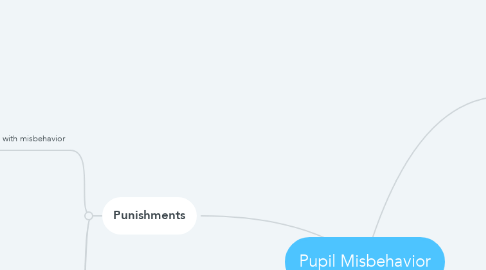
1. Punishments
1.1. Effective actions dealing with misbehavior
1.1.1. Target correctly : the nessesity of identify the first who engaged in the misbehavior.
1.1.2. Be firm: a verbal reprimand should be clear and firm.
1.1.3. build on rapport and mutual respect: the teacher's disapproval should matter to the pupil; hence a statement of disapproval will carry significant weight.
1.1.4. Emphasise the positive: reprimands should emphasise what pupils should be doing rather than complain about what they are doing.
1.1.5. Follow through psychologically when reprimand is given, it should be accompanied by the appropiate non-verbal cues.
1.1.6. Avoid confrontations: do not force pupils into a situation where an emotional and heated exchange results.
1.1.7. Criticise the behaviour : criticism of the behavior and not the pupil allows the pupil to dissociate themselves from the act.
1.1.8. Use private rather than public reprimands: this minimises the tendency for reprimands to disrupt the flow of the lesson and causes less embarrassement to pupils.
1.1.9. Be pre emptive: reprimands aimed at pre-empting misbahavior are more effective than those which follow only after repeated or extended misbahavior.
1.1.10. State rules and rationale: a reprimand can usefully consist os a statement of the rule being transgressed.
1.1.11. Avoid making hostile remarks : once a pupil feels personally disliked , disaffection and alienation may quickly follow.
1.1.12. Avoid unfair comparisons: pupils are particulary sensitive to reprimands that involve stereotyping, labelling or comparison with other pupils
1.1.13. Be consistent : reprimands should be consistently applied to pupils so that they are able to establish what behavior will be dealt with.
1.1.14. Avoif idle threats : avoid reprimands wich explicitly threaten certain consequences.
1.1.15. Avoid reprimanding the whole class: having to reprimand the whole class is very serius, implies that the teacher has been unable to stem the tide of individuals acts.
1.1.16. Make an example: in order to estblish the teachers' authority.
1.2. Retribution:
1.2.1. Justice requires that bad acts are folllowed by morally deserved punishment.
1.3. Deterrence:
1.3.1. The punishment is intended to put off the pupil or other pupil from similar misbehavior in the future through fear of the consequences.
1.4. Rehabilitation:
1.4.1. The punishment is intended to assist the pupil in understanding the moral wrongdoing of the misbehavior and desiring not to repeat it again.

